You'll be greeted to discover an unexpected artistic and monumental treasure. The medieval town, built as a military fortress, unconquered during the long wars between Siena and Florence and today famous all over the world for the famous Brunello wine, offers you an extra experience to discover a precious heritage.
The ticket is valid for the whole day without time limits.
In the St. Augustine church, you can discover recently renovated 14th-century paintings illustrating the life of the Saint and of the main Saints and Blesseds of Augustinian devotion. In the annexed convent, where the Civic Museum, Diocesan Museum and Archaeol... more
In the St. Augustine church, you can discover recently renovated 14th-century paintings illustrating the life of the Saint and of the main Saints and Blesseds of Augustinian devotion. In the annexed convent, where the Civic Museum, Diocesan Museum and Archaeological Museum collections are located, you can admire precious wood sculptures on gold backgrounds from the Senese school. In the archaeological collection are exhibited artefacts from Poggio Civitella ancient excavation, which is one of the most important Etruscan fortifications in Central Italy (can be visited by appointment). Walking through the Montalcino's streets, due to the town's prominent position, you can discover suggestive views, equally absolute masterpieces ranging from the Crete to the Val d'Orcia and Maremma to the city of Siena. Inside the Town Hall (can be visited by appointment), the former hospital of Santa Maria della Croce, you'll find a precious cycle of 16th-century paintings related to the work of Vincenzo Tamagni, a collaborator of Sodoma and Raffaello and, just outside the city walls, you can visit the church of the Virgin Mary of Graces and archaeological excavation in Poggio Civitella (can be visited by appointment). Only a few kilometres from the historical centre of Montalcino, is located the ancient Benedictine Abbey of Sant'Antimo, dating back to Carolingian origin.
lessFrom 1st November to 31st March:
Saturdays and Sundays from 10:30 a.m. to 5:30 p.m.
Closed from 2nd to 24th November.
From 8th to 11th December: daily from 10:30 a.m. to 7:00 p.m.
From 26 December to 8 January: daily from 10:30 a.m. to 7:00 p.m.
(on 1st January opening at 12:00 p.m.)
Last admission 30 minutes before closing.
NOTE: Church hours may vary due to Liturgy-related activities.
By train and bus:
The nearest station to Montalcino is in Buonconvento (10 km away). From here, a bus goes to Montalcino (info: www.sienamobilita.it). Montalcino can also be reached by bus from Siena (38 km away).
By car:
To reach Montalcino from Milan (405 km away), take the A1 motorway towards Rome. Exit at Firenze-Impruneta, take the Firenze-Siena superstrada. Get off at Siena Sud and take the SS2 (Cassia) towards Rome. Drive through the town of Monteroni d'Arbia, Buonconvento, turn right onto the SP45 towards Montalcino. To reach Montalcino from Rome (219 km away) there are two options: the first is to drive along the SS2 (Cassia) towards Siena. Near Torrenieri, turn right towards Montalcino. The second option is to take the A1 motorway in the direction of Florence. Exit at Chiusi and take the SS146. Drive through Chianciano Terme, Montepulciano, Pienza and San Quirico d'Orcia; then take the SS2 (Cassia) in the direction of Siena and follow the signs for Montalcino. To reach Montalcino from Grosseto (55 km away), take the SS223 Grosseto-Siena and turn right towards Paganico SP64. Following the signs for Monte Amiata, turn left for Sant'Angelo Scalo SP52. Then continue in the direction of Montalcino.
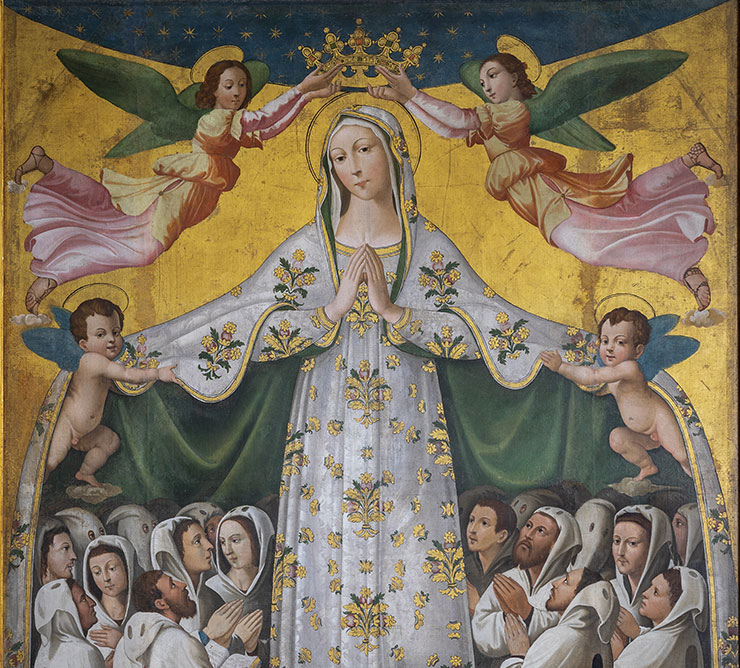
The city's rich artistic heritage is preserved in St. Augustine's ancient monastery complex. From one of the Convent's cloisters, visitors can access to the museum's collection of valuable polychrome wooden statues and precious gold-ground paintings from Senese school from the many churches of the ancient diocese: among the oldest artworks we find the Atlantic Bible and a 12th-century painted Cross, once located at the nearby St Antimo's Abbey. In the archaeological section, it's possible a reconstruction of the Etruscan origins of the Montalcino area, with special focus on the finds unearthed at the Poggio Civitella excavation site. The St. Augustine's church is decorated with precious frescoes mainly related to the activity of the Senese painter Bartolo di Fredi, active in the town in the 1480s. The apse features detailed episodes from the life of St Augustine.
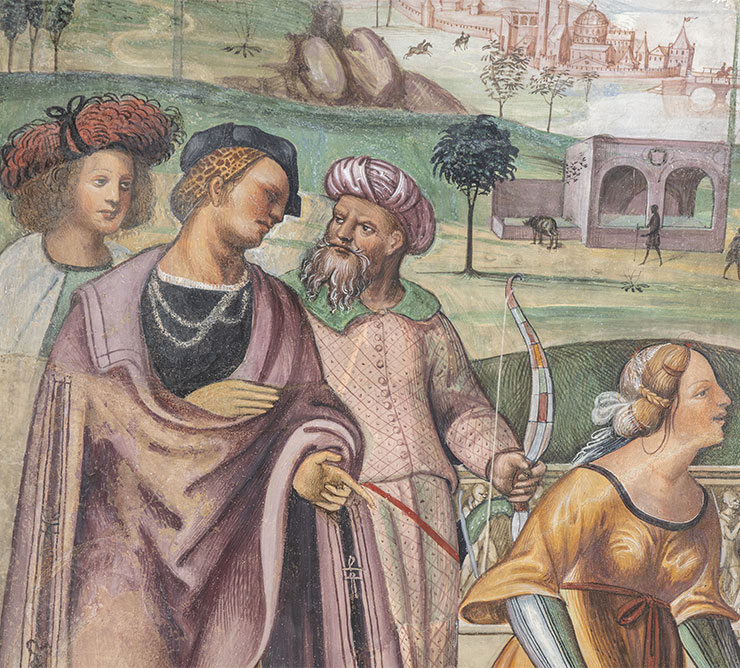
Inside the Town Hall in Piazza Cavour is conserved a small jewel of Montalcino Renaissance: it's the Ancient Scriptoriumm of the Santa Maria della Croce's Hospital painted in the early 16th century by Vincenzo Tamagni, a disciple of Raffaello. On the long walls of the room is presented a serie of heroines and illustrious figures from the Bible and ancient history which are painted in monochrome. A few shelves painted in trompe l'oeil with inkwells, bill books and tickets, evoke the room's original purpose.
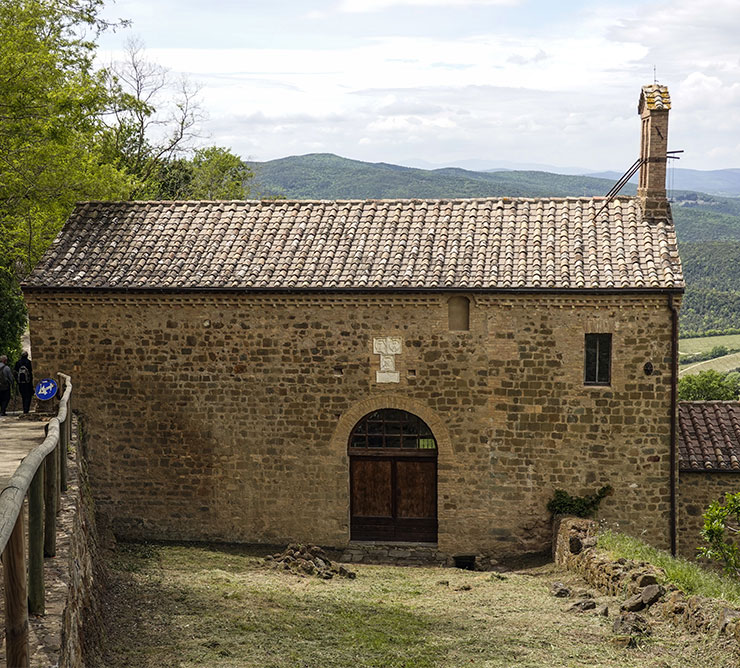
Our Lady of Graces' Church is located near the historical centre of Montalcino, just outside Porta Burelli. It was documented as early as the 14th century and it was under the jurisdiction of the St Antimo's Abbey: here the Abbot of Antimo used to grant indulgences to pilgrims. The church's interior is decorated with 14th-century Senese school frescoes depicting the Virgin Mary with Child, Angels and Saints of the 16th century and the Risen Christ between the Virgin Mary, St John the Baptist and Angels holding Passion's symbols.
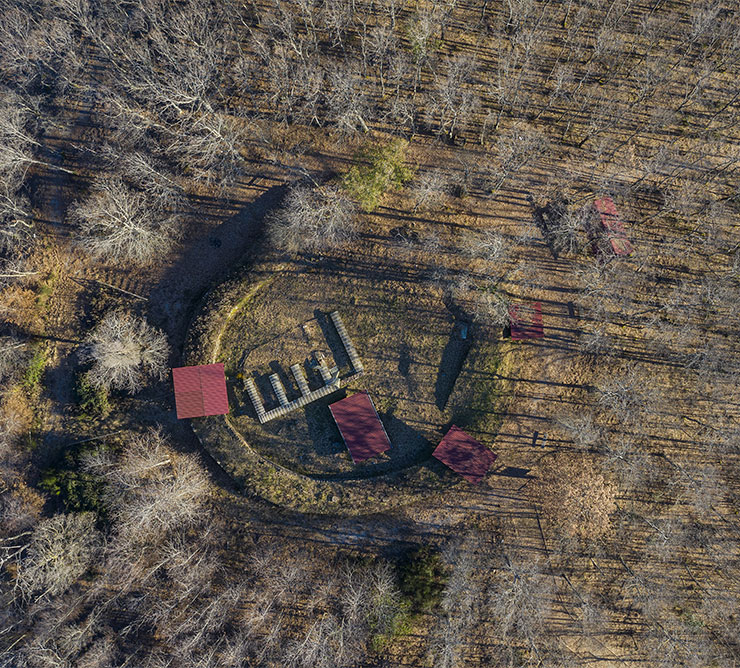
The Etruscan fortified complex of Poggio Civitella was built on the highest point of Montalcino hill as a military outpost of the city of Chiusi. The strategic importance of the site can be perceived even today thanks to the view from here that extends from the Tuscan-Emilian Apennines to the Tyrrhenian Sea and on to the mountains of Umbria and Lazio. Inside and outside the three city walls, built between the 6th and 1st century B.C., were found residential buildings and daily-use objects now exhibited in the city's Archaeological Museum.
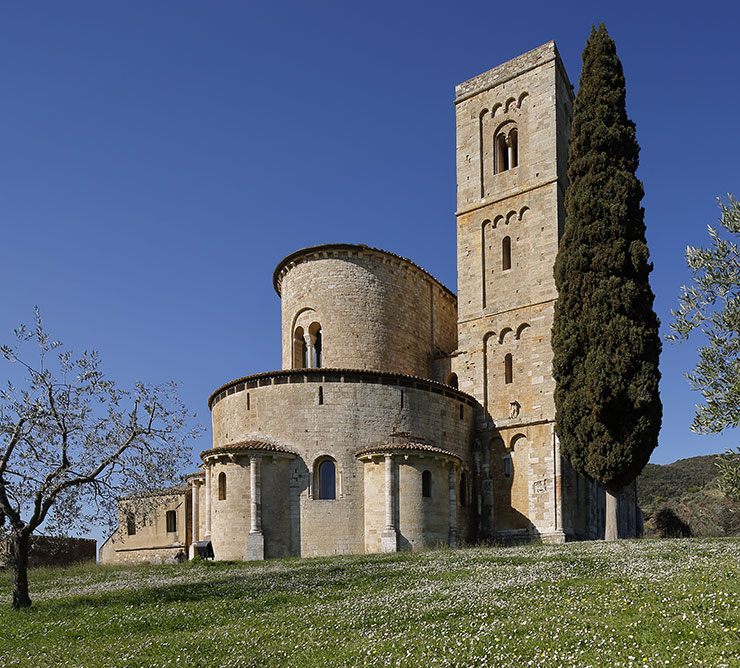
The St Antimo Abbey, dating back to Carolingian origin, is located just a few kilometres from the historical centre of Montalcino, in the Val di Starcia, a torrent of the Orcia river. The ancient Benedictine Abbey features a striking 12th-century church, built with onyx from the ancient caves of Castelnuovo dell'Abate. Its architecture is characterised by refined sculptural decoration and structural styles close to the French Romanesque style. The ancient Abbey's rooms, the monastic garden and the Abbey Church are open to visitors and can be visited with video-guided tours.